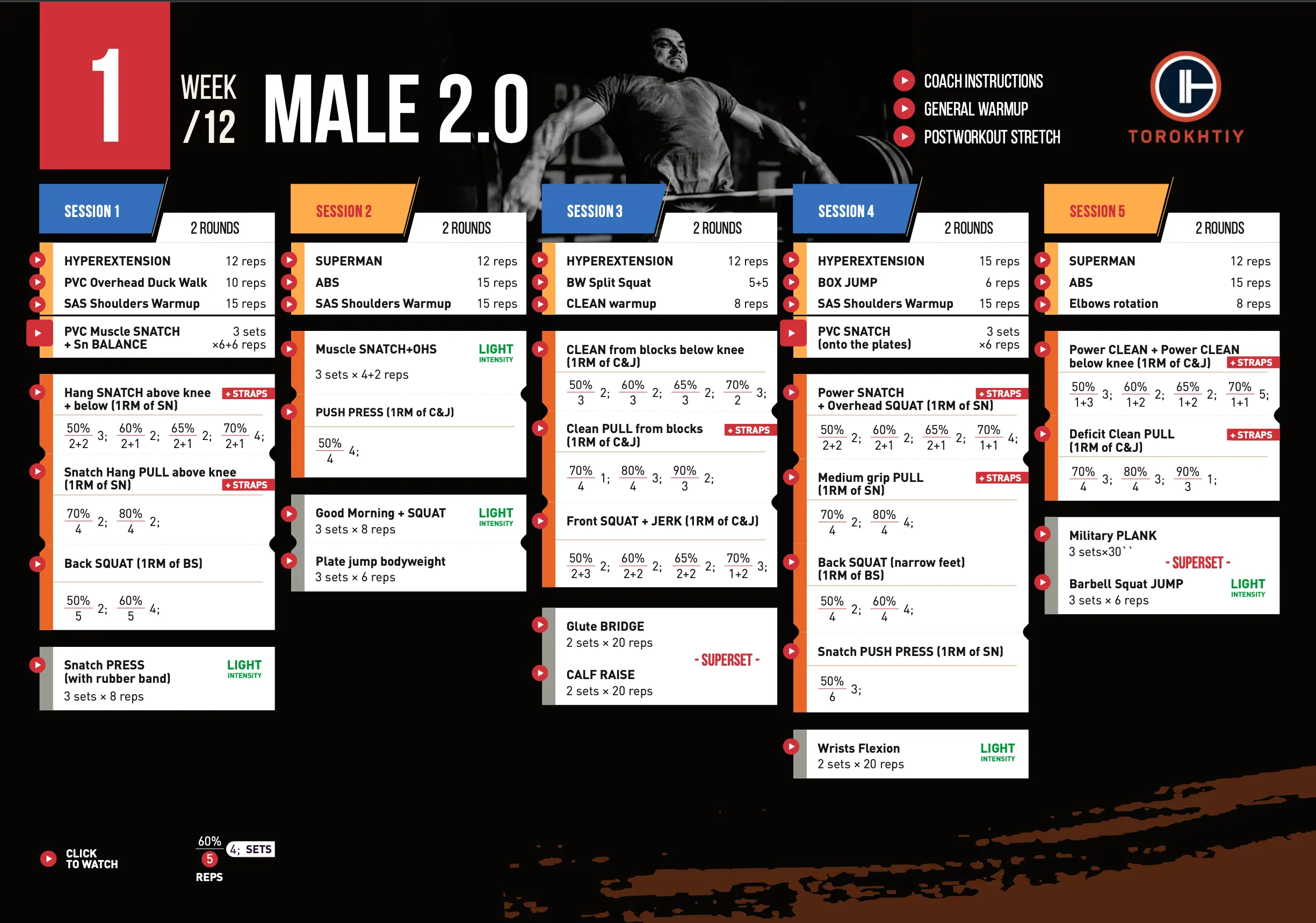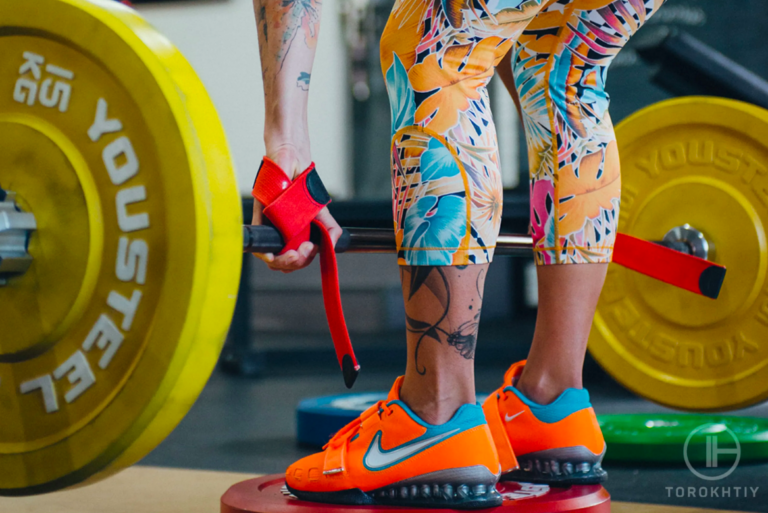Trainings without injuries: a method proven by a champion in weightlifting

In a perfect world the Olympic champion is always healthy, positive, rosy-cheeked and able to adjust his body over the years in order to fight for gold medals at the peak of his own abilities. But in reality, the greatest victories come when we overcome the most. Alexey Torokhtiy, 2012 London Olympic champion in weightlifting, stepped on the podium despite a serious injury. We will find out what helped him, and how this experience will help you to protect yourself from injuries.
Every school physical training class used to start with a warm-up, but what do you remember about it now? Flexions, stretching, swinging hands? Certainly that is all. And even now, when you attend to a fancy gym, we bet your workout is just a treadmill.
If that’s true, you take a pretty serious risk. “In the past, when my work lied in lifting the bar, I devoted a lot of time to warm-up,” explains Alexey Torokhtiy. “The coach constantly scolded me, because the warm-up didn´t take less than 40 minutes. And I even used stretching, although many thought it was unnecessary before strength trainings. But when you are in good shape, you have a trained body and you work with a barbell for about twenty times a week, stretching becomes essential, without it you become clumsy like a bear and … you run the risk of getting injured.”
Alexey did not have any serious injuries, but according to him, he was always taking a great risk: “I had to listen to myself and my body regarding my knees. Before the Olympics in London, I was very unpleasantly injured. It wasn’t so serious to make me take painkillers before performing, of course, but after the Games I didn’t train at all for two years to get rid of my injury – I started having problems with mymeniscus. This problem appeared two years before the Olympics and completely changed all my training plans. My knees dictated all the training, I was forced to completely eliminate all squats and lifts from it.”
You can say that injuries are inevitable in a professional athlete’s life but you would be wrong: you will be much more likely to meet a simple fitness enthusiast at a traumatologist’s office than a potential Olympic champion. It’s all about the arrogance of the average person, because everyone thinks that “warming up is not necessary for a strong man and would not help a weak one.” Torokhtiy categorically disagrees: “Of course, not all athletes pay equal attention to warm-ups, I noticed this at all serious competitions and at the Olympic Games too. And now, as I train people, I have to talk about this in a straight way. Yes, many successful athletes do not warm up, but this does not mean that they have to be taken as an example.”
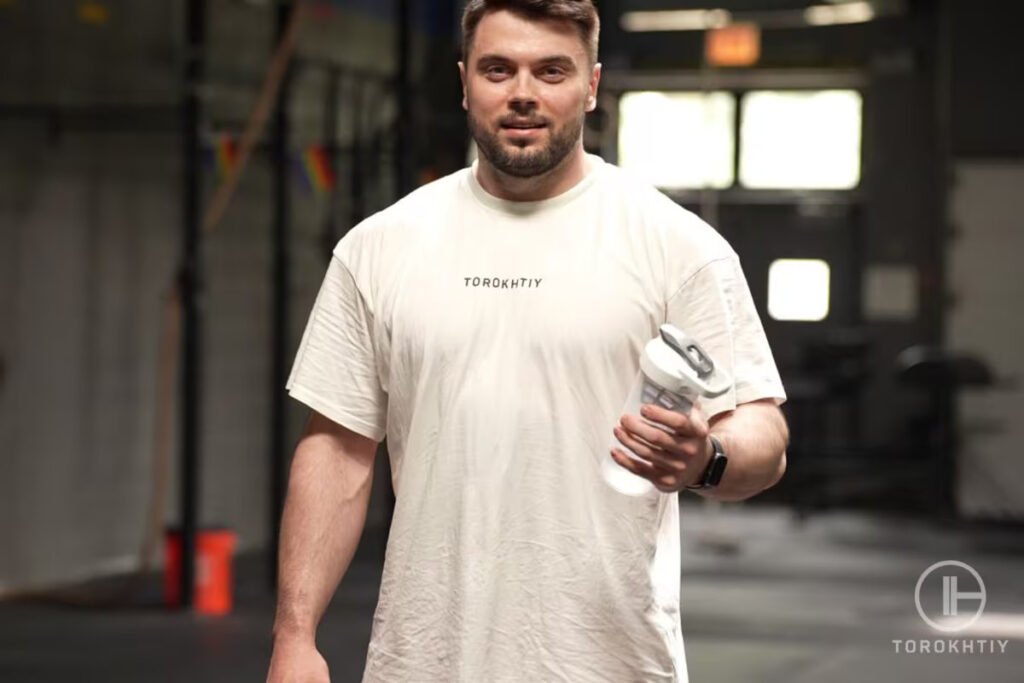
Since it holds no blessing in disguise, the situation with the knees helped Alexey find methods that today help his students achieve solid success without getting annoying injuries, and they can help you too. “This set of exercises, which I included in the warm-up, helped me to win in the end,” says Alexey. “You understand: if you remove all squats and lifts from a weightlifter’s training program in two years, it is very difficult to achieve serious results. And I couldn’t even walk up the stairs normally, therefore I put a lot of emphasis on technique and its small nuances and strengthened my small muscles with particular persistence – I worked on stabilizers, that is – I did what nobody has paid attention to before not only in the national team but anywhere. Everybody practiced with emphasis on force in a squat and a burden, and I had to avoid it.”
12 Torokhtiy´s Friends
Alexey calls this complex a basic for all those who want to avoid injuries or recover from those that already occured. These exercises will allow you to strengthen hands, knees, shoulders and back. Include them in the warm-up before training or in a hitch after it.
1. Gymnast´s wrists
What it’s for: to strengthen and stretch the ligaments of the wrists.
Get on all fours, hands on wrists, fingers facing themselves. Try not to bend your elbows strongly [A]. Now, bring the wrists in and rest the wrists on the knuckles of the fists [B]. Return to the starting position and repeat. Make two or three sets of 10–15 repetitions before training. Perform this exercise before training from three to four times a week.
2. Pinch grip
What it’s for: to strengthen fingers and grip.
Stand up straight with your feet shoulder width apart, taking a 10–15 kg barbell disc, holding it with a pinch grip in your right hand [A]. Raise your hand up quickly and throw the disk up to the chest level [B]. While the disk is in the air, grab it with the fingers of your left hand and lower it down by inertia alone [B].
Make two or three sets of 10–15 repetitions. Perform this exercise after training, but not more than twice a week. According to Alexey, it is not desirable to train the forearm and grip more than twice a week. Repeat the movement immediately, changing the hand at the top point again.
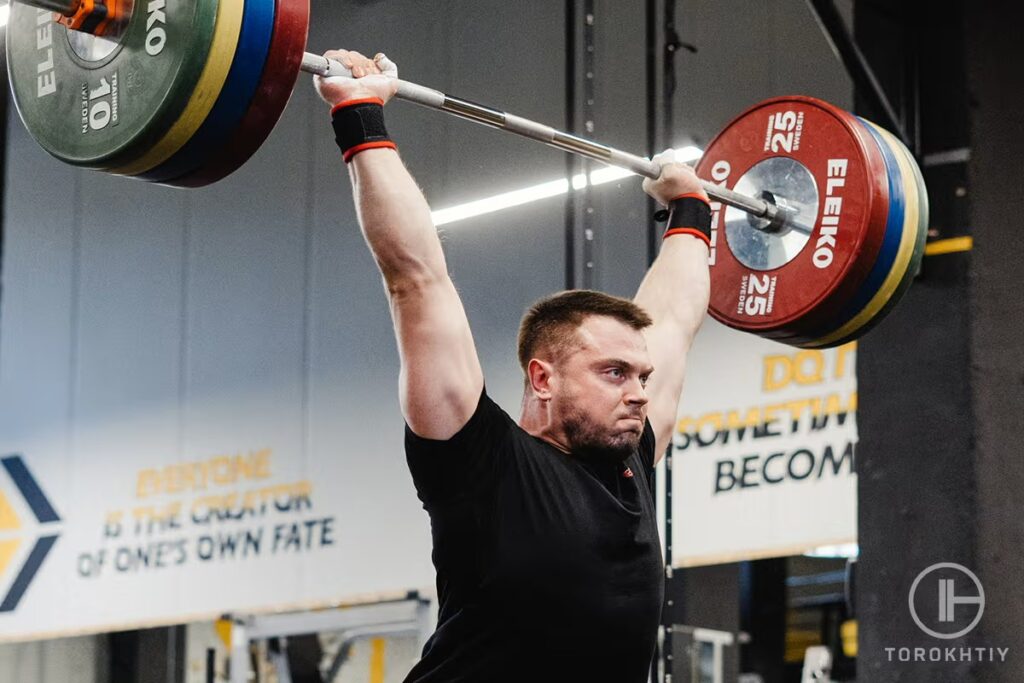
3. Wrists bending with a bar
What it’s for: to strengthen the forearms.
Sit on your haunches, take the bar with a grip from below at shoulder width, turning your palms up. Arms should be placed parallel to each other and horizontal to the floor. Put the bar down on your fingertips [A]. Now, without changing the position of the body, bend the wrists and lift the barbell towards yourself [B].
Return to the starting position and repeat. Do this exercise only after training, 3 sets of 10–20 repetitions. Not more often than twice a week.
4. Wrists extension with a bar
What it’s for: to strengthen the forearms.
From the same starting position, take a bar with a grip from below with your palms facing down. Bend the wrists and lower the barbell [A]. Now, without changing the position of the body, unfasten the wrists and lift the barbell towards yourself [B]. Return to the starting position and repeat. This exercise should also be performed only after training and again, 3 sets of 10–20 repetitions. Not more often than twice a week.
5. Hack squat
What it’s for: to strengthen the knees.
Stand with your heels on a stack of two barbell discs, putting your feet shoulder-width apart or a bit closer. Put your palms on your shoulders, bend your knees slightly, take your pelvis back so that your shins are vertical, this is the starting position [A]. Keeping balance, squat down to the parallel position of the hips with the floor [B]. Return to the starting position without fully straightening your knees. Repeat. Do 2 sets of 10-15 repetitions in the warm-up. Exercise must be performed in a particularly slow mode.
6. Inclinations with a barbell + squat
What it’s for: this difficult exercise is perfect for a warm-up and strengthening the back of the thigh and lower back.
Stand up straight, putting the bar on the trapeze and holding the barbell as you usually do with squats. Feet shoulder-width apart, legs slightly bent at the knees, back straight [A]. Pulling the pelvis back, bend forward, trying to lower the body to the horizontal line[B]. Without straightening, lower the pelvis, thus dropping into the position of a deep squat [B]. Now raise the pelvis again, returning to the [T] inclined position.Stand straight and return to the starting position [D]. Repeat. Do two or three sets of 6 repetitions before trainings two or three times a week.
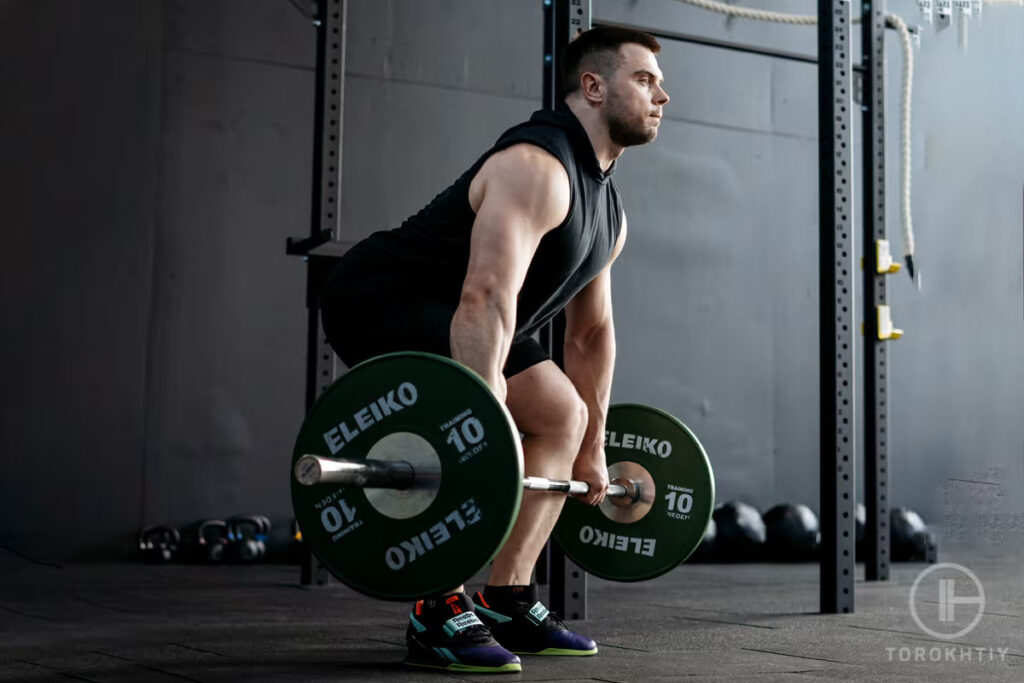
7. Standing barbell press from chest for stabilization
What it’s for: to strengthen the muscles of the shoulder girdle, the core and the small stabilizers of the main working joints.
Put 5-15 kg disks (depending on your level) on the barbell on rubber shock absorbers. Stand up straight with your legs straight. Put your feet shoulder-width apart, take a barbell with a grip a little bit wider than your shoulders and gently drop the barbell on your shoulders.
Chest open, bring elbows forward [A]. Gently squeeze the barbell over your head and lock it in this position for three to four seconds, resisting the swaying of the bar [B]. Return to the starting position. Repeat. Perform three or four sets of 6-10 repetitions after the training.
8. Standing press from behind the head for stabilization
What it’s for: to strengthen the shoulder girdle muscles, the thorax and the small stabilizers of the main working joints, to develop the mobility of the shoulder joints.
Put the same barbell with the rubber disk on your back. Take it with the widest snatch grip possible so that the fingers press the bar bushings. Straighten your legs, open your chest, elbows straight down [A]. Squeeze the barbell over yourself, at the same time straightening your arms, turning your elbows back and shrugging your shoulders. Stay in this position for three to four seconds [B], suppressing the vibrations of the bar. Return to the starting position. Repeat. Perform three to four sets of 6-10 repetitions after training.
Important: if your shoulders’ mobility is not like that of an Olympic champion, it is better to perform the previous exercise – standing barbell press from chest.
9. Joining with a shock absorber in the split step
What it’s for: to warm up the shoulder joints and torso muscles.
Fix the rubber at about your knee level, take the shock absorber lever with both hands, turn your back to the shock absorber fixation place and move two steps away from it. Stand in the lunge position, putting your left foot forward. Hands apart to the side, pointing the elbows back [A]. By connecting trajectories, bring your hands in front of you, keeping them slightly bent at the elbows [B].
Return to the starting position and repeat. Do 2 sets of 10 repetitions in a warm-up.
Important: if you are not a professional weightlifter and you can’t say exactly which leg is the supporting one, then change your legs with each set.
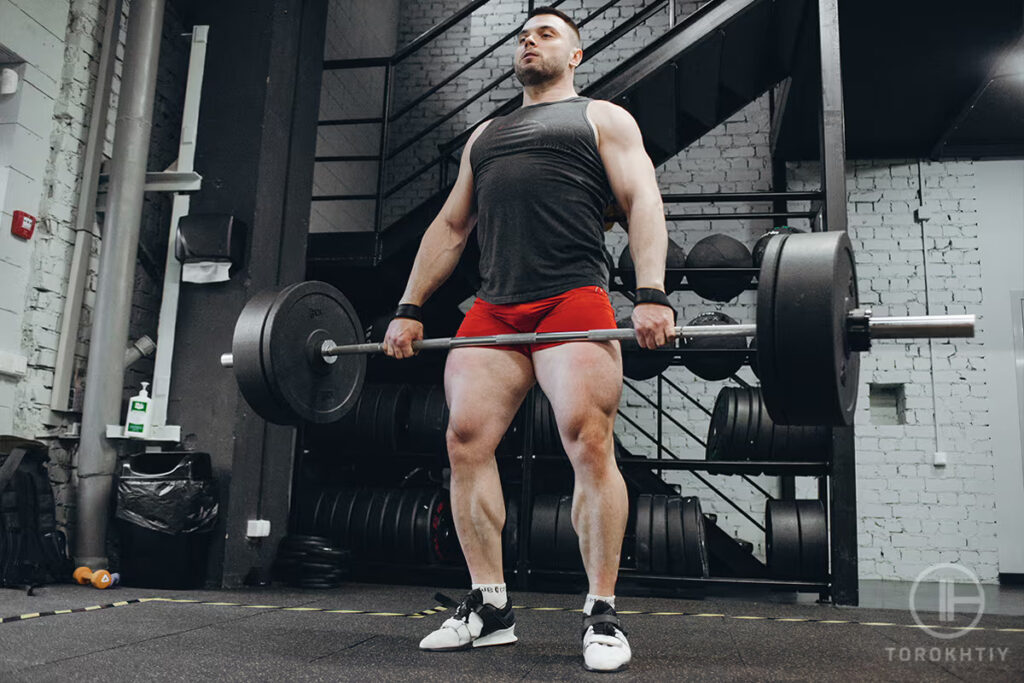
10. Consecutive swinging with a shock absorber in the split step
What it’s for: to warm up the shoulder joints and torso muscles.
Turn your back to the shock absorber fixation place, also move a few steps away from it and take the lunge position, putting your left foot forward. Raise your left hand up, leave your right hand down a little behind you [A]. Now, without bending your arms in your elbows and working only with your shoulder joints, change hands [B]. Return to the starting position – it will be 1 repetition. Do 2 sets of 10 repetitions in a warm-up. Also change your legs with each approach.
11. “Lumberjack” with shock absorber
What it’s for: to warm up the shoulder joints and torso muscles.
Turn your back to the rubber fixation place, put your feet slightly bent at the knees shoulder-width apart. Hold the shock absorber levers with both hands and put the hands down to the left thigh [A]. Raise your arms above head widely [B] and, without stopping, also in an arc form, put your hands to the right thigh [C]. Return to the starting position by making the same circular motion in the opposite direction. Repeat. Perform 2 sets of 5 repetitions in each direction in a warm-up.
🔻12-Week Olympic Weightlifting Program by Oleksiy Torokhtiy
Transform your strength and technique with our 12-week Olympic Lifting Program, made up of 5 sessions per week.
It is designed by Olympic Champion for athletes who are looking to set new personal records safely in Snatch or Clean & Jerk.
Program details:
- 12 weeks + 2 bonus weeks
- 45-120 minutes per session
- 50+ specific exercises/98 video instructions
- Primary focus on Olympics Lifts
- Full access to all training content
- Weekly video coach instructions
Start now and boost your weightlifting results!
12. Barbell split squat
What it’s for: to develop the mobility of the hip joints, balance and strengthen the knees.
Put the barbell on your shoulders, holding it with a grip a little wider than your shoulders. Put your feet in a split step at a distance of two steps.The back is straight, the scapulas are flattened [A]. With both legs bent at the knees, get down into a deep lunge, touching the floor completely with the knee of the leg standing behind [B]. Straighten your legs, return to the starting position and repeat. When all the repetitions with one leg are over, take a breath, change your leg and repeat. Starting with your weight, increase the weight of the barbell to 20-30 kg, not more. Go down slowly. Perform 2 sets of 8 repetitions with each leg in a warm-up.
You might be interested in:
Why Trust Us?
With over 20 years in Olympic Weightlifting, our team does its best to provide the audience with ultimate support and meet the needs and requirements of advanced athletes and professional lifters, as well as people who strive to open new opportunities and develop their physical capabilities with us.
By trusting the recommendations of our certified experts in coaching, nutrition, dietology, and sports training programming, as well as scientific consultants, and physiotherapists, we provide you with thorough, well-considered, and scientifically proven content. All the information given in the articles concerning workout programming, separate exercises, and athletic performance, in general, is based on verified data. We ensure that you can rely on our professionals’ pieces of advice and recommendations that can be treated as personalized ones which will benefit you and fully meet your needs.
The product testing process is described in more detail here
Author: Sergii Putsov
Head of Sport Science, PhD
Best Results: Snatch – 165 kg,
C&J – 200 kg
Sergii Putsov, Ph.D., is a former professional weightlifter and National team member, achieving multiple medals in the 94 kg weight category at national competitions. With a Master’s degree in “Olympic & Professional Sport Training” and a Sport Science Ph.D. from the International Olympic Academy, Greece, Sergii now leads as the Head of Sport Science. He specializes in designing training programs, writing insightful blog articles, providing live commentary at international weightlifting events, and conducting educational seminars worldwide alongside Olympic weightlifting expert Oleksiy Torokhtiy.

